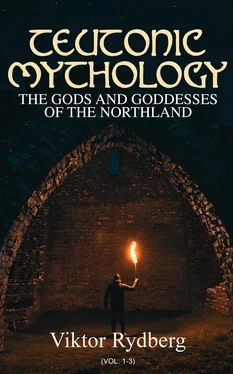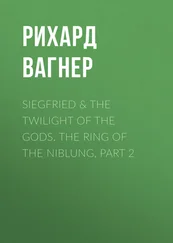Thus the question whether Aurboda ever dwelt in Asgard is answered in the affirmative. We have discovered her, though she is the daughter of a giant, in the circle around Menglad-Freyja, where she has occupied a subordinate position as maid-servant. At the same time we have found that Gulveig-Heid has for some time had an occupation in Asgard of precisely the same kind as that which belongs to a dis serving under the goddess of fertility. Thus the similarity between Aurboda and Gulveig-Heid is not confined to the fact that they, although giantesses, dwelt in Asgard, but they were employed there in the same manner.
The demonstration that Gulveig-Heid-Angerboda is identical with Aurboda may now be regarded as complete. Of the one as of the other it is related that she was a vala of giant-race, that she nevertheless dwelt for some time in Asgard, and was there employed by Frigg or Freyja in the service of fertility, and that she possessed the sword, which had formerly belonged to Frey, and by which Frey is to fall. Aurboda is Frey's mother-in-law, consequently closely related to him; and it must have been in behalf of a near relation that Frey and Njord demanded satisfaction from the Asas when the latter slew Gulveig-Heid. Under such circumstances it is utterly impossible from a methodological standpoint to regard them otherwise than identical. We must consider that nearly all mythic characters are polyonomous, and that the Teutonic mythology, particularly, on account of its poetics, is burdened with a highly-developed polyonomy.
But of Gulveig-Heid's and Aurboda's identity there are also other proofs which, for the sake of completeness, we will not omit.
So far as the very names Gulveig and Aurboda are concerned the one can serve as a paraphrase of the other. The first part of the name Aurboda , the aur of many significations may be referred to eyrir , pl. aurar , which means precious metal, and is thought to be borrowed from the Latin aurum (gold). Thus Gull and Aur correspond. In the same manner veig in Gulveig can correspond to boda in Aurboda . Veig means a fermenting liquid. Boda has two significations. It can be the feminine form of bodi , meaning fermenting water, froth, foam. No other names compounded with boda occur in Norse literature than Aurboda and Angrboda .
Ynglingasaga [20](ch. 4) relates a tradition that Freyja kendi fyrst med Ásum seid , that Freyja was the first to practise sorcery in Asgard. There is no doubt that the statement is correct. For we have seen that Gulveig-Heid, the sorceress and spreader of sorcery in antiquity, succeeded in getting admission to Asgard, and that Aurboda
is mentioned as particularly belonging to the circle of serving dises who attended Freyja. As this giantess was so zealous in spreading her evil arts among the inhabitants of Midgard, it would be strange if the myth did not make her, after she had gained Freyja's confidence, try to betray her into practising the same arts. Doubtless Völuspa and Saxo have reference to Gulveig-Heid-Aurboda when they say that Freyja, through some treacherous person among her attendants, was delivered into the hands of the giants.
In his historical account relating how Freyja ( Syritha ) was robbed from Asgard and came to the giants but was afterwards saved from their power, Saxo ( Hist. , 331; cp. No. 100) tells that a woman, who was secretly allied with a giant, had succeeded in ingratiating herself in her favour, and for some time performed the duties of a maid-servant at her home; but this she did in order to entice her in a cunning manner away from her safe home to a place where the giant lay in ambush and carried her away to the recesses of his mountain country. ( Gigas fæminam subornat, quæ cum obtenta virginis familiaritate, ejus aliquamdiu pedissequam egisset, hanc tandem a paternis procul penatibus, quæsita callidius digressione, reduxit; quam ipse mox irruens in arctiora montanæ crepidinis septa devexit. ) Thus Saxo informs us that it was a woman among Freyja's attendants who betrayed her, and that this woman was allied with the giant world, which is hostile to the gods, while she held a trusted servant's place with the goddess. Aurboda is the only woman connected with the giants in regard to whom our mythic records inform us that she occupied such a position with Freyja; and as Aurboda's character and part, played in the epic of the myth, correspond with such an act of treason, there is no reason for assuming the mere possibility, that the betrayer of Freyja may have been some one else, who is neither mentioned nor known.
With this it is important to compare Völuspa, 26, 27, which not only mentions the fact that Freyja came into the power of the giants through treachery, but also informs us how the treason was punished:
Tha gengo regin oll
A ráukstola,
ginheilog god
oc um that gettuz
hverir hefdi lopt alt
levi blandit
etha ett iotuns
Oths mey gefna
thorr ein thar va
thrungin modi,
hann sialdan sitr
er hann slict um fregn.
These Völuspa lines stand in Codex Regius in immediate connection with the above-quoted strophes which speak of Gulveig-Heid and of the war caused by her between the Asas and Vans. They inform us that the gods assembled to hold a solemn counsel to find out "who had filled all the air with evil," or "who had delivered Freyja to the race of giants;" and that the person found guilty was at once slain by Thor, who grew most angry.
Now if this person is Gulveig-Aurboda, then it follows that she received her death-blow from Thor's hammer, before the Asas made in common the unsuccessful attempt to change her body into ashes. We also find elsewhere in our mythic records that an exceedingly dangerous woman met with precisely this fate. There she is called Hyrrokin . A strophe by Thorbjorn Disarskald preserved in the Younger Edda, states that Hyrrokin was one of the giantesses slain by Thor. But the very appellation Hyrrokin , which must be an epithet of a giantess known by some other more common name indicates that some effort worthy of being remembered in the myth had been made to burn her, but that the effort resulted in her being smoked ( rökt ) rather than that she was burnt; for the epithet Hyrrokin means the "fire-smoked." For those familiar with the contents of the myth, this epithet was regarded as plain enough to indicate who was meant. If it is not, therefore, to be looked upon as an unhappy and misleading epithet, it must refer to the thrice in vain burnt Gulveig. All that we learn about Hyrrokin confirms her identity with Aurboda. In the symbolic-allegorical work of art, which toward the close of the tenth century decorated a hall at Hjardarholt, and of which I shall give a fuller account elsewhere, the storm which from the land side carried Balder's ship out on the sea is represented by the giantess Hyrrokin. In the same capacity of storm-giantess carrying sailors out upon the ocean appears Gymer's wife, Aurboda, in a poem by Refr ;
Færir björn, thar er bára
brestr, undinna festa,
Opt i Ægis kjopta
úrsvöl Gymis völva.
"Gymer's ancient-cold vala often carries the ship amid breaking billows into the jaws of Ægir." Gymer, Aurboda's husband, represents in the physical interpretation of the myth the east wind coming from the Ironwood. From the other side of Eystrasalt (the Baltic) Gymer sings his song (Ynglingasaga, 36); and the same gale belongs to Aurboda, for Ægir, into whose jaws she drives the ships, is the great open western ocean. That Aurboda represents the gale from the east finds its natural explanation in her identity with Angerboda "the old," who dwells in the Ironwood in the uttermost east, " Austr byr hin alldna i iarnvithi (Völusp.).
Читать дальше











